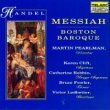PIFAThis is a moment that Charles Jennens could not have predicted, for it comes from the realm of opera, not scripture. The prophecy scenes have come to an end, a Child has been born, and the instrumental ensemble raises a curtain on a scene in the country. The term Pifa means “pipe”, as in a shepherd’s recorder or flute. Handel’s music is a siciliano, a rustic Italian dance in a lilting compound quadruple meter (quite singular in Messiah). A pedal tone provides evidence of bagpipe drones while three violins and a viola charm us with a naive melody, untutored in its awkward phrase lengths and utterly simple harmony. [Excerpt 26] We are being transported to the fields where idealized sheep are being tended by nobly simple shepherds, who entertain themselves with music in the night. RECITATIVE (SOPRANO)There were shepherds abiding in the field, keeping watch over their flock by night. The pastoral scene evoked by the Pifa is confirmed by the soprano in this dry recitative; the pedal in the continuo keeps us aware of the shepherds’ presence and their simplicity. ACCOMPAGNATO (ACCOMPANIED RECITATIVE) (SOPRANO)And lo, the angel of the Lord came upon them, and the glory of the Lord The accompaniment for the soprano is most interesting, for its rising 16th-note arpeggios over repeated 8th notes in the viola and continuo bass suggest the pulsing wing beats9 of the angel; the tempo is marked Andante. The solo violins, in parallel thirds, pair nicely as wings. The continuo bass is quite high, ranging between D and F above middle C until the shepherds are reported to be afraid. The effect is one of hovering almost motionless. [Excerpt 27] RECITATIVE (SOPRANO)And the angel said unto them, Fear not: for behold, I bring you good tidings of great joy, The return to dry recitative for the angel's message allows the words to be the focal point. The first portion of the announcement is in the major mode (through “all people”), but the actual pronouncement of the birth of the Savior is in the minor. There is a subtle vulnerability, perhaps also a foreboding of the Messiah’s eventual sacrificial death, and certainly a reflection of the human condition in this harmonic shift. [Excerpt 28] ACCOMPAGNATO (ACCOMPANIED RECITATIVE) (SOPRANO)And suddenly there was with the angel a multitude of the heaven’ly host, Again, Handel uses accompanied recitative for the appearance of a "multitude" of angels. There is much more rapid activity in the violins, which are in an even higher range than with the appearance of the single angel. Now the tempo is marked Allegro. Even the narrating soprano seems more energized, for her range extends up to a high A. [Excerpt 29] The word attacca at the cadence indicates that the recitative must move immediately to the following chorus.
PAGE 1 2 3 4 5 6 7 8 9 10 11 12 13 9 Van Camp, A Practical Guide for Performing, Teaching and Singing “Messiah”, 55, tentatively suggests this image. Given the continued use of the string activity wherever the angels are present in the next recitative and the following chorus, I think Handel intended the reference. |

